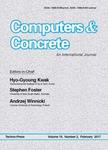版权所有:内蒙古大学图书馆 技术提供:维普资讯• 智图
内蒙古自治区呼和浩特市赛罕区大学西街235号 邮编: 010021

作者机构:Univ Seoul Dept Architectural Engn 163 Siripdaero Seoul 02504 South Korea Univ Seoul Smart City Interdisciplinary Major Program 163 Siripdaero Seoul 02504 South Korea Mokwon Univ Div Architecture 88 Doanbuk Ro Daejeon 35349 South Korea
出 版 物:《COMPUTERS AND CONCRETE》 (Comput. Concr.)
年 卷 期:2022年第30卷第1期
页 面:75-83页
核心收录:
主 题:flexural behavior negative moment post -tensioned method prestressed concrete tendon stress
摘 要:This study introduced a post-tensioned precast concrete system that was developed and designed to improve the performance of joints by post-tensioning. Full-scaled specimens were tested to investigate flexural performances at the negative moment region, where the test variables were the presence of slabs, tendon types, and post-tensioned lengths. A specimen with slabs exhibited significantly higher stiffness and strength values than a specimen without slabs. Thus, it would be reasonable to consider the effects of a slab on the flexural strength for an economical design. A specimen with unbonded mono-tendons had slightly lower initial stiffness and flexural strength values than a specimen with bonded multi-tendons but showed greater flexural strength than the value specified in the design codes. The post-tensioned length was found to have no significant impact on the flexural behavior of the proposed post-tensioned precast concrete system. In addition, a finite element analysis was conducted on the proposed post-tensioned precast concrete system, and the tests and analysis results were compared in detail.